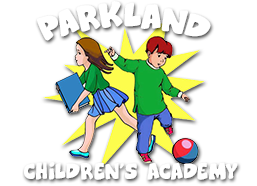
Let the fun begin! Parkland Children’s Academy has created a list of fun preschool science experiment activities for you to do at home with your children. We believe that teaching children about science will foster a learning environment where your children can grow and develop. Science teaches us to ask questions, and there is no better way to learn about our weird and wonderful world than through science!
Magic Milk
What you need:- One dinner plate
- Milk
- Food Coloring (3 different colors of your preference)
- Dishwashing liquid
Method:
Pour a thin layer of milk onto the dinner plate (pour enough so that it covers the entire bottom of the plate.) Take each food coloring and pour one to three drops of food coloring in the milk. Make sure that you have space between the drops of food coloring that fall in the milk- you do not want the colors to mix just yet. Now, to become the magician, add a drop of dishwashing liquid onto the tip of your finger (make sure that the children do not see this). Tell your children you will make some ‘rainbow milk’ and touch the milk with the tip of your soapy finger. Watch the colors move and mix as the milk particles become disturbed, creating a rainbow swirl! Ask your child if they would like some ‘magic’ too and rub some soap onto their fingers with your soapy finger- as if you are passing on the magic! This experiment is a perfect to learn about simple chemical reactions. You can also use this as an opportunity to talk about blending and mixing colors.
Grow a Bean Plant
What you need:- Paper Towels or Cotton Balls
- Water
- 6 Beans of your choice (some common bean to grow are Sugar Beans, Lima Beans and Kidney Beans).
Method:
Line the jar with paper towels or cotton buds. Tuck 6 beans on the outer sides of the paper towel in the jar. You must be able to see them through the jar so that you can watch them grow. Next, pour a little bit of water into the jar to soak the cotton or paper towels. The paper towels should be soaked, but don’t put too much water so that you end up filling the jar. You don’t want your beans to drown! This experiment is great for young children because it teaches them about the wonders of the natural world. They will learn patience as they wait to watch the beans grow each day. You can teach them about responsibility by giving them the job of watering the beans each day!
Create Salt Crystals
What you need:- Salt
- Water and a kettle to boil
- A Jar
- String
- A Spoon
Method:
Boil the water. Once it has been boiled, immediately pour it into the jar. Put a spoon into the jar when you pour in the hot water to prevent the jar from cracking. Note that adults should do this part of the experiment only. You don’t want your children handling boiling water, or accidents may occur! Only let the children continue with the experiment once the water has cooled. Once you have poured in the hot water, add about 6 table spoons of salt into the jar of water while it’s still hot and stir the salt in the jar until it dissolves completely. While you wait for the solution to cool, measure a piece of string that can hang in the jar that will be long enough to reach the water. Lastly, tie a string onto the middle of the spoon and lie the spoon across the top of the jar. Make sure the string is hanging in the solution. Now wait a few days and leave the solution undisturbed and watch for salt crystals! If you like, you can explore the different types of crystals that can grow by using different elements! For example, compare the use of tap water with distilled water, or use different types of salt. Each salt crystal is unique!
Homemade Lava Lamp
What you need:- Vegetable Oil
- Water
- Food Coloring
- Alkaline/Anti-Acid Tablets (used for heartburn like Tums or example)
- Glass/Jar
Method:
Add a few drops of your favorite food coloring to ½ cup of water. Fill a glass of oil about ¾ full, then add the colored water until it is about 2 inches from the top of the glass. Crush the alkaline/anti-acid tablet into pieces into the glass and let the magic begin! Watch as the colorful bubble start to swirl up and down in the glass. This experiment teaches children that water and oil do not mix. The anti-acid pieces cause carbon dioxide bubbles to form- creating tiny water bubbles. These tiny bubbles bring the colorful water blobs to the surface, and when it reaches the top, it pops, causing the bubbles to sink again.
So, there you have it! 4 exciting and easy experiments to do in your own home. We believe that including science experiments like these into our preschool curriculum is essential as it introduces STEM to the children. At Parkland Children’s Academy, we are dedicated to laying solid foundations through education, safety, health and development in a fun and friendly manner. We encourage preschool activities that stimulate the minds of children.
